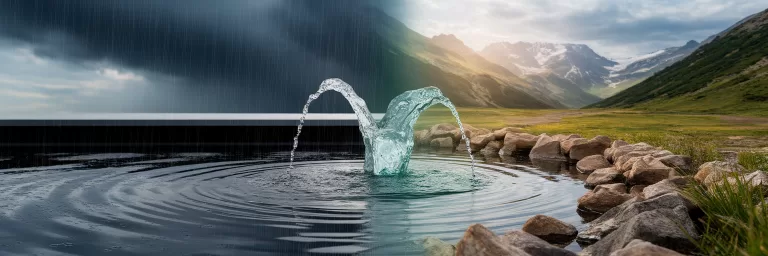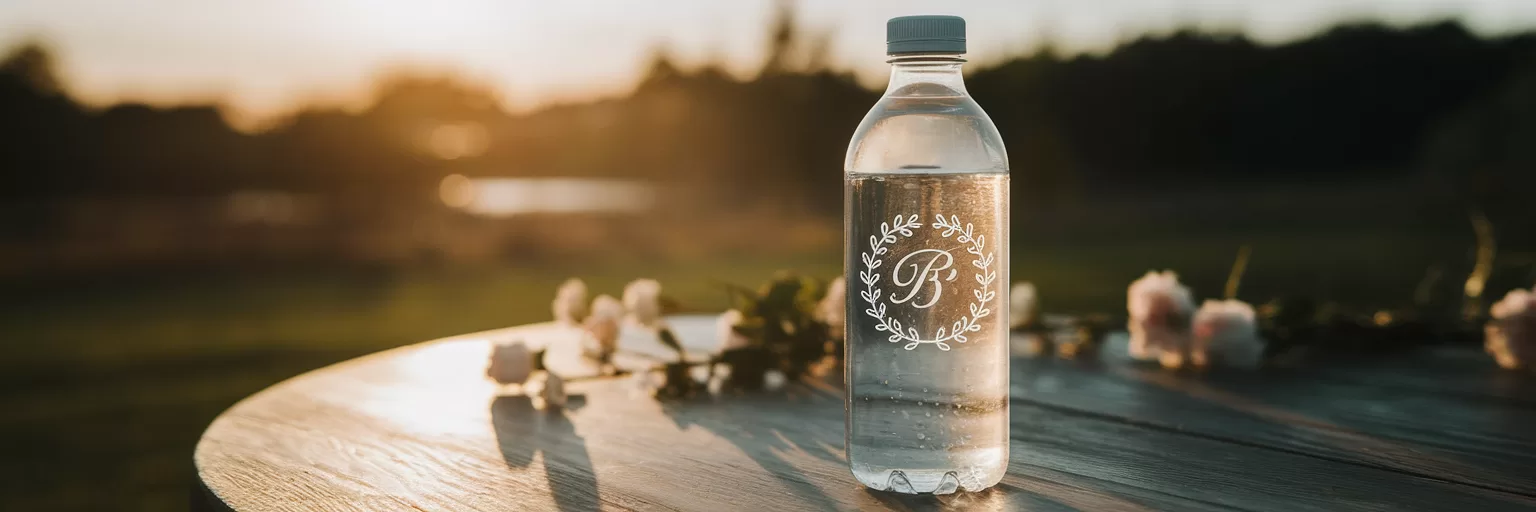The notion of collecting free water directly from the sky certainly has its appeal. Many people find themselves wondering, is rainwater safe to drink? While it might seem like the purest form of water, rainwater often carries hidden risks that are not immediately apparent. For businesses and event organizers who require dependable hydration, understanding these potential pitfalls is essential. I Want My H2O offers a consistently safe and high-quality alternative with its single-source Blue Ridge Mountain spring water. This option is perfect for custom bottled water and comprehensive event hydration solutions, ensuring everyone has access to safe drinking water for events.
The Allure and Uncertainty of Rainwater
The romance of rainwater collection is understandable. It falls from the sky, seemingly untouched and pure. This perception often fuels the desire for self-sufficiency and a connection to natural resources. However, the journey of a raindrop is more complex than it appears, and what starts clean can quickly gather impurities.
The Common Perception of Rainwater Purity
Rainwater is often idealized as a pristine source. It’s free, it feels elemental, and tapping into it can seem like an environmentally conscious choice. This image of purity is compelling, leading many to believe it’s inherently safe. People imagine it as water in its most natural state, untouched by human processing. This perception, while appealing, overlooks the environmental interactions that occur before it ever reaches a collection barrel.
Contamination from Atmosphere to Surface
A raindrop begins its descent relatively clean, high in the atmosphere. But as it falls, it acts like a tiny sponge, absorbing airborne pollutants. This can include dust, industrial emissions, pollen, and even microscopic particles from vehicle exhaust, especially in or near urban areas. Once it reaches a collection surface, such as a roof, the contamination continues. Materials like asphalt shingles can leach chemicals, while gutters often accumulate leaves, bird droppings, and other organic debris. Each stage of this journey introduces new contaminants, meaning that by the time rainwater is collected, it is rarely safe to drink directly without significant treatment. The question of “is rainwater safe to drink?” becomes more complicated when considering this path.
Identifying Potential Dangers in Untreated Rainwater
While the previous section touched on how rainwater gathers impurities, it’s important to understand the specific types of contaminants that can make untreated rainwater a gamble for your health. These invisible threats can range from microscopic organisms to harmful chemicals, making the clear appearance of rainwater deceptive.
Invisible Threats: Airborne and Biological Contaminants
As rainwater passes through the atmosphere, it can pick up pollutants like sulfur dioxide, volatile organic compounds (VOCs), and even microplastics, particularly if you’re near cities or industrial zones. Once it lands and collects, biological hazards become a significant concern. Bacteria such as E. coli and Salmonella, viruses, and parasites like Giardia can thrive in collected rainwater. These often originate from animal waste on roofs or decaying organic matter in gutters, posing serious risks to anyone who consumes the water without proper purification.
Chemical Risks from Surfaces and Surroundings
The surfaces rainwater touches before collection are critical sources of chemical contamination. Roofing materials can leach heavy metals like lead or copper, especially from older roofs or plumbing components. If your collection area is near agricultural land, pesticides and herbicides can be carried by wind and rain into your supply. Even the material of the storage tank itself, if not food-grade, can introduce unwanted chemicals. These substances can accumulate in the body over time, leading to various health issues.
The Missing Minerals in Rainwater
Beyond the presence of contaminants, there’s also what rainwater lacks. Unlike spring water, which filters through rock and soil, acquiring beneficial minerals along the way, rainwater is naturally very soft. This means it’s deficient in essential minerals like calcium and magnesium. These minerals are not only vital for bodily functions, including bone and dental health, but they also contribute significantly to the taste of water. Spring water’s mineral content gives it a pleasant taste that rainwater often lacks. The Centers for Disease Control and Prevention (CDC) offers guidelines on rainwater collection, often highlighting the risks from various contaminants if water is not properly treated. You can find more information on the CDC website regarding safe water practices, which underscores why asking “is rainwater safe to drink?” usually leads to a cautionary answer without thorough treatment.
| Contaminant Type | Examples | Common Sources | Potential Health Impact |
|---|---|---|---|
| Biological | E. coli, Salmonella, Legionella, Giardia | Animal feces, bird droppings, decaying organic matter in gutters | Gastrointestinal illnesses, infections, respiratory problems |
| Chemical (Atmospheric) | Sulfur dioxide, nitrogen oxides, VOCs, particulate matter | Industrial emissions, vehicle exhaust, airborne dust | Respiratory issues, contribution to acid rain, long-term health effects |
| Chemical (Surface & Environmental) | Lead, copper, zinc, arsenic, pesticides, herbicides, asphalt compounds | Roofing materials (shingles, flashing), gutters, plumbing, agricultural runoff, industrial fallout | Heavy metal poisoning, nervous system damage, endocrine disruption, cancer risks |
| Physical Particulates | Dust, pollen, soot, microplastics, sediment | Airborne particles, roof degradation, debris in collection systems | Allergic reactions, respiratory irritation, aesthetic issues (cloudiness, taste) |
This table summarizes common contaminants found in untreated rainwater, their origins, and potential health risks. Data is based on common environmental science findings and public health advisories regarding water quality.
The Complexities of Making Rainwater Potable
Understanding the potential contaminants in rainwater, as detailed earlier, naturally leads to the question of treatment. Making rainwater safe for consumption is not a simple task. It involves a multi-step process and an ongoing commitment that many individuals and businesses might find surprisingly demanding, especially when compared to the convenience of professionally supplied bottled water.
Essential Steps for Rainwater Treatment
Transforming collected rainwater into potable water typically requires several stages of purification. Skipping any of these can leave harmful contaminants in the water. A common approach includes:
- Pre-filtration: This initial step uses mechanisms like leaf screens and first-flush diverters. Their job is to remove larger debris such as leaves, twigs, and coarse sediment before the water even enters the main storage tank.
- Sediment filtration: After pre-filtration, finer particles still remain. Sediment filters, often using cartridges, are employed to remove these smaller suspended solids, improving water clarity.
- Activated carbon filtration: This stage is crucial for addressing dissolved contaminants. Activated carbon filters are effective at removing many chemicals, pesticides, and VOCs, as well as improving taste and odor by adsorbing organic compounds.
- Disinfection: The final and most critical step is to eliminate microbiological threats. Common methods include UV sterilization, which uses ultraviolet light to kill bacteria and viruses, chlorination, or consistent boiling for smaller quantities. Each method has its own requirements for effectiveness.
The Ongoing Commitment: System Maintenance and Testing
Installing a rainwater treatment system is only the beginning. Consistent maintenance is non-negotiable. Filters need regular changing, UV lamps have a limited lifespan and require replacement, and if using chemical disinfection, levels must be monitored and replenished. Beyond maintenance, frequent and comprehensive water quality testing is essential. This means testing not just for bacteria, but also for a range of chemical contaminants to ensure the system is performing as expected. This can be costly and requires a degree of expertise. Public water supplies and reputable bottled waters must meet stringent regulatory standards, like those set by the EPA in the US. Achieving this level of safety with a private rainwater harvesting system is a demanding task, often impractical for businesses needing reliable safe drinking water events or for daily operational use.
Spring Water: Nature’s Purified and Mineral-Rich Hydration
After considering the significant efforts involved in making rainwater safe, it’s refreshing to turn our attention to spring water. This natural source offers a stark contrast, providing hydration that is both purified by the earth and enriched with beneficial minerals, largely avoiding the surface contamination issues discussed earlier.
The Natural Filtration Journey of Spring Water
Spring water originates from underground aquifers, often deep within the earth. Its journey to the surface is a slow percolation through layers of rock, sand, and soil. This natural process acts as an extensive filtration system, removing impurities and protecting the water from many of the airborne and surface contaminants that affect rainwater. By the time it emerges at a spring, the water has undergone a purification process crafted by nature itself, resulting in remarkable clarity and purity.
Rich in Beneficial Minerals
As spring water travels through geological formations, it doesn’t just get filtered; it also dissolves and absorbs minerals from the surrounding rock strata. This is how it becomes naturally enriched with compounds like calcium, magnesium, and potassium. These minerals are not only essential for human health, contributing to everything from bone strength to nerve function, but they also give spring water its characteristic crisp and pleasant taste. This is a key difference from rainwater, which, as we noted, is naturally soft and lacks these beneficial minerals unless they are artificially added.
Protected Sources and Rigorous Quality Control
Reputable bottled spring water providers, such as I Want My H2O, source their water from protected springs, like those in the pristine Blue Ridge Mountains. These sources are carefully managed to prevent contamination. Furthermore, the journey from spring to bottle involves stringent quality control measures. This includes regular testing for a wide array of potential contaminants, adherence to strict hygiene protocols, and processing in dedicated facilities designed to maintain purity. I Want My H2O, for instance, uses a single, dedicated facility to ensure consistency and quality in every bottle of its bulk spring water. The Food and Drug Administration (FDA) sets quality standards for bottled water, including spring water, which cover contaminants and ensure labeling accuracy. Reputable bottlers adhere to these FDA regulations, providing an additional layer of assurance for consumers.
Why Spring-Sourced Bottled Water Excels for Business and Event Needs
For businesses and event organizers, the choice of water is more than just about hydration; it’s about safety, brand perception, and operational efficiency. While rainwater presents complexities and uncertainties, professionally bottled spring water, particularly from a dedicated supplier like I Want My H2O, offers clear advantages that directly address these professional requirements.
Guaranteed Safety and Quality for Peace of Mind
When hosting an event or providing water in a business setting, ensuring the safety of that water is paramount. You simply cannot afford the risk associated with improperly treated or potentially contaminated sources. Professionally bottled spring water meets strict, legally mandated quality standards. This eliminates the guesswork and potential liability that can come with DIY solutions like rainwater collection. Choosing a trusted spring water provider means peace of mind, knowing that every bottle is consistently safe and pure.
Elevating Your Brand with Customization
Beyond safety, water can be a powerful branding tool. With custom bottled water from I Want My H2O, businesses can transform a simple necessity into a sophisticated marketing statement. Imagine your company logo or event theme elegantly displayed on a high-quality label. This attention to detail projects professionalism and care, enhancing your brand’s image. I Want My H2O even offers free label design assistance, making it easy to achieve high branded bottled water quality that aligns perfectly with your messaging. It’s a subtle yet effective way to leave a lasting positive impression.
Effortless Logistics and Superior Experience
Organizing an event or managing a business involves countless details. Water logistics shouldn’t add to the burden. Ordering from I Want My H2O simplifies this entirely. With nationwide low-cost shipping, flexible order quantities to suit any need, and the assurance of BPA-free, recyclable disposable bottles, the process is seamless. This contrasts sharply with the complexities of setting up, maintaining, and monitoring a rainwater harvesting and treatment system. High-quality spring water also enhances the guest or customer experience with its clean, refreshing taste, something that can be inconsistent with treated rainwater. For reliable event hydration solutions, professionally bottled spring water is the practical and superior choice.
| Factor | DIY Rainwater Collection & Treatment | I Want My H2O Spring Water |
|---|---|---|
| Safety & Consistency | Variable; depends on rigorous, consistent treatment & frequent testing. High risk of oversight. | Guaranteed; meets FDA standards. Sourced from protected Blue Ridge Mountain springs, processed in a single facility. |
| True Cost & Effort | High hidden costs: treatment systems, ongoing maintenance, filter/lamp replacements, regular testing, potential liability if issues occur. Labor-intensive. | Transparent pricing for a complete solution: premium spring water, BPA-free bottles, custom bottled water labels, and reliable delivery. |
| Convenience & Logistics | Complex: requires system setup, management, expertise, and emergency backup if system fails. | Effortless: simple ordering for bulk spring water, free label design assistance, nationwide shipping. Focus on your event, not water management. |
| Brand Impact & Guest Experience | Neutral at best; potential for negative perception or health concerns if taste/quality is off. | Positive: enhances brand image with professional branded bottled water quality. Provides a refreshing, trustworthy hydration experience for guests. |
This table compares key factors for businesses and event organizers when choosing a water source, highlighting the advantages of I Want My H2O’s spring water. Assumptions include standard costs for rainwater treatment systems and typical service offerings for custom bottled water.
Making the Clear Choice for Dependable Hydration
Throughout this discussion, we’ve explored the journey of rainwater from sky to tap, contrasting its inherent uncertainties with the natural purity and managed quality of spring water. For any organization prioritizing safety, convenience, and brand integrity, the decision becomes straightforward.
Rainwater’s Risks Versus Spring Water’s Reliability
The question “is rainwater safe to drink?” generally leans towards ‘no’—at least not without significant, consistent, and expertly managed treatment. The risks of atmospheric and surface contamination, coupled with the complexities and ongoing costs of purification, make rainwater an unreliable option for most professional settings. In contrast, spring water, naturally filtered and sourced from protected environments, offers inherent reliability and purity. This difference is crucial when the health and satisfaction of guests, clients, or employees are on the line.
The I Want My H2O Commitment: Quality and Convenience
At I Want My H2O, our commitment is to provide an unparalleled hydration solution. We achieve this by using single-source pure Blue Ridge Mountain spring water, ensuring every bottle meets our high standards for taste and quality. Our water is packaged in BPA-free, recyclable disposable bottles, reflecting our dedication to both consumer well-being and environmental considerations. Because we manage the entire process in our dedicated, locally-based manufacturing facility, we maintain consistent quality control from source to delivery. When you consider the true cost—factoring in not just the price per bottle but also the peace of mind, brand enhancement, and effortless logistics—choosing a trusted supplier like I Want My H2O is a sound investment in your organization’s reputation and operational smoothness.
For dependable, high-quality hydration that reflects well on your business or event, I Want My H2O provides the clear solution. Prioritize safety, quality, and your brand by choosing professionally sourced spring water. Contact us today for a free quote on your custom bottled water or bulk spring water needs, and let us handle your hydration with the excellence you deserve.








